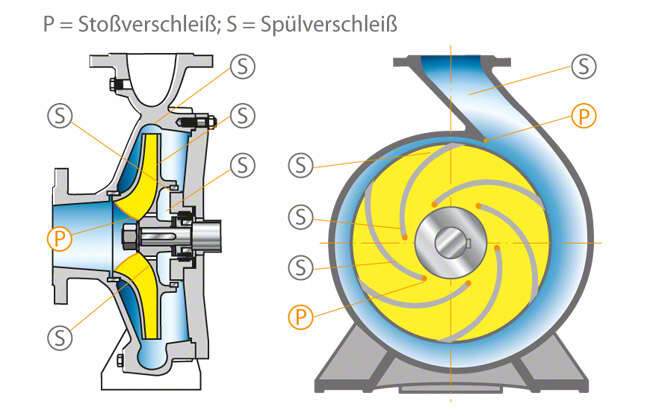Abrasion
Abrasion is a form of wear, caused when the solid components in the fluid handled act mechanically on the surface of the material.
Factors that are conducive to abrasion in centrifugal pumps
- 2nd to 3rd power of relative velocity between the fluid handled and the pump material
- Simultaneous loading of the pump materials due to corrosion, cavitation or mechanical abrasion
- Increase approximately proportional to the concentration of solids
- Hardness ratio of solids (e.g. quartz) and pump materials
- Density ratio of solids (e.g. ore) and vehicles
- Sharp-edged solids (e.g. sinter) as opposed to round particles
- Grain diameter of solids (e.g. gravel)
- Significant deviation of the operating point from the optimum flow rate (Qopt)
In the case of standard centrifugal pumps where there are no special measures to inhibit wear, the permissible solids concentration and, where applicable, the grain diameter and flow velocity are limited on the basis of empirical values.
In the case of centrifugal pumps, special measures are required in terms of the design or the materials to deal with the hydraulic solids transport.
For example, the pumps used within this context have robust external bearings and strong shafts. In addition, the walls are thicker in those areas where abrasive wear is anticipated. High flow velocities are avoided whenever possible and in turn this generates only slight differences in pressure.
Those components that are likely to suffer wear after a certain operating period are designed so that they can be replaced with a minimum of effort and interruption time.
The lined pumps are constructed according to this principle, in that their wear parts (hard-facing) are made from extremely hard materials and so only need to undergo machining at a small number of points.
The lined pumps are constructed according to this principle, in that their wear parts (hard-facing) are made from extremely hard materials and so only need to undergo machining at a small number of points.
A large number of pumps also feature speed control, which makes it possible to extend the operating period once the equipment starts to be affected by wear in spite of the increasing unbalance and the decreasing head.
In narrow controlled gap seals, solids cause sliding wear. This can be countered by flushing with clear water (which is very elaborate during operation) or by using very wear-resistant materials.
In narrow controlled gap seals, solids cause sliding wear. This can be countered by flushing with clear water (which is very elaborate during operation) or by using very wear-resistant materials.
The effects of material hardness and the angle of impact are governed by the following factors: If the solid particles strike a hard and brittle surface at a large angle of impact (approximately 90º), after causing initial compression and subsequent fatigue in the material, they then cause particles to be released from the material. Tough materials suffer less damage as a result of this kind of wear caused by collisions and impacts.
If the solid particles hit a soft surface at a small angle of impact (approximately 15°), they rub off material particles in the same way as during grinding. Hard materials are less affected by this scouring (hydroabrasive wear). See Fig. 1 Abrasion

Fig. 1 Abrasion: Wear intensity as a function of material and angle of impact
As most abrasive damage is caused by scouring, it is advisable to use very hard materials (e.g. NORIHARD®, chilled silicon casting, NIHARD®, hard-facings with tungsten carbide or cobalt alloys, ceramics).
Only a few parts of the pump are subjected to wear caused by collisions or impacts. These include the leading edges of casing tongues, impeller and diffuser vanes (see vane) as well as the front sides of baffles that face against the flow. At these points, wear-resistant and tough materials should be used. See Fig. 2 Abrasion

Fig. 2 Abrasion: Wear-prone areas in a volute casing pump
